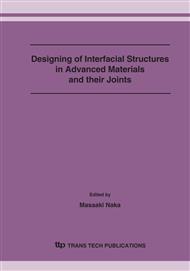p.109
p.115
p.123
p.129
p.135
p.141
p.147
p.155
p.161
TEM Studies on Phase Stability in Nanometer-Sized Alloy Particles
Abstract:
TEM is one of the most powerful experimental tools for the study of nanometer-sized particles. In the present work, the finite size effect on both the stability of two-phase microstructure and the solid solubility has been examined by in situ TEM using particles in the Au-Ge system. The size effect on the two-phase microstructure is rather small when the size of particles is larger than approximately 10 nm in diameter. However, the effect becomes strong in particles smaller than about 10 nm in diameter and an amorphous structure appears instead of the crystalline two-phase microstructure. The solid solubility in each solid solution in nanometer-sized alloy particles with a two-phase microstructure gradually increased as the particle size decreased. The enhancement of solid solubility was large in gold solid solution as compared with the in germanium solid solution.
Info:
Periodical:
Pages:
135-140
Citation:
Online since:
September 2007
Authors:
Keywords:
Price:
Сopyright:
© 2007 Trans Tech Publications Ltd. All Rights Reserved
Share:
Citation:


